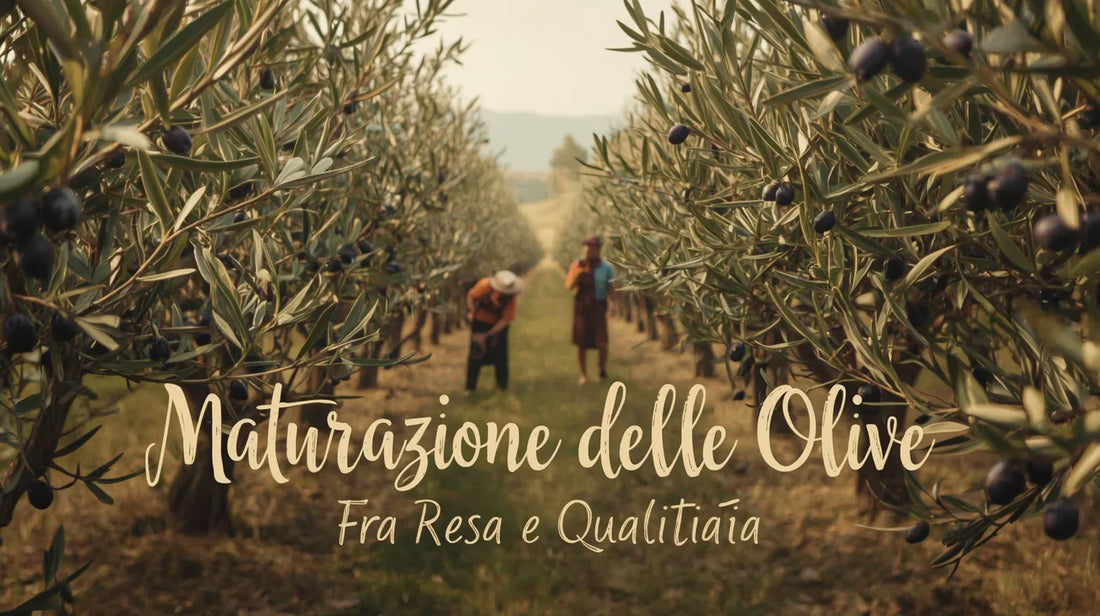
Olive Ripening: Between Yield and Quality
Share
Humanity has known about the olive tree since before recorded history. Before the Industrial Revolution and the consumer society, subsistence agriculture was essentially the way in which almost all of humanity experienced life and interacted with the world.
In this context, people's main problem was not the football team or the color of the upholstery on their new car, but rather how to get through the winter.
The Olive Tree: A Precious Plant
The olive tree is a truly important ally in this regard: this evergreen plant, resistant to disease and parasites, produces fruits from which this dense, oily, extremely calorific liquid can be obtained.
In fact, lipids make up almost all of olive oil and account for a whopping 9 kcal per gram, compared to 4 kcal for proteins and carbohydrates. Furthermore, oil retains its nutritional value virtually forever if stored in the same way: our grandmothers kept it in the cellar, where it freezes in the winter, and then scooped it out while still solid with a ladle.
Oil as a Survival Resource
With this information, it is now easy for us to understand how the ability to obtain or produce oil has been fundamental for thousands of years.
We know oil for its nutritional qualities, its health benefits, and its unique flavor. But in the past, these factors were secondary: the only thing that mattered was the quantity, the YIELD of the olives, whether the oil I managed to produce this year would allow my family to survive until next season.
The Compromise: Yield vs. Quality
From this perspective, given that olives, in general and regardless of cultivar, tend to increase the quantity of oil produced as they ripen, it was natural to try to push the harvest as far forward as possible, even until January, in order to obtain the maximum possible yield.
This strategy also has another effect, however: as the olive ripens, all the nutritive and antioxidant components, first and foremost the polyphenols, tend to be consumed and disappear, severely degrading the organoleptic properties and therefore the flavour of the oil.
A Hard-to-Die Mentality
This mentality is actually still very much alive today. Almost all of our mill customers, to whom we offer our pressing service, almost always ask us, "What's the yield this year?" It seems that, when it comes to their oil, no one asks about the polyphenol content or the quality of the olives.
Extra Virgin Olive Oil Today
Extra virgin olive oil is no longer a basic staple, but has become the jewel in our pantry. We seek quality because we understand its benefits and its ability to transform our dishes from a mere combination of ingredients into a symphony of flavors where the oil, like an orchestra conductor, enhances the quality of each ingredient and accompanies them on our palate.
A New Trend: Early Harvest
It's therefore understandable that the tendency to delay harvesting is disappearing today: in fact, the opposite trend is gaining ground. An early harvest leads to a lower yield, but the oil quality is significantly higher.
📊 Table: Harvest Time and Oil Quality
| Harvest Time | Period | State of the Olives | Impact on Quality | Recommended Use |
|---|---|---|---|---|
| Early Harvest | September - October | Green or slightly purple | High polyphenol content, intense, bitter and spicy flavour | Dressings, tastings, luxury EVOOs |
| Media Collection | November - December | Purple | Balanced taste, softer texture | Cooking, salads |
| Late Harvest | January - February | Black, fully ripe | Milder flavor, higher yield, fewer antioxidants | Everyday use, less valuable |
Price and Availability: A Consumer Dilemma
It is easy to understand how, by the simple law of supply and demand, an oil produced with a lower yield but of higher quality commands a higher price.
This can put the consumer in difficulty: trying to obtain an early-producing oil during the September-October period at a good price is not easy.
The price is high not only because of the oil's high quality and limited availability, but it is also exacerbated by the timing, which falls during a seasonal period when oil supply is at its lowest, given that the start of the new season necessarily coincides with the furthest point from the last production season.
The Vision of the Ottaviani Oil Mill
At Frantoio Ottaviani, we think differently. Our goal is to build a lasting relationship of trust with our customers, allowing them to obtain our oil at a pre-agreed price, locked in via our pre-orders.
Thank you for your attention, and if interested, please consider our pre-order offer of EVOO for the new season.
Sources
Ripening indices and harvesting times of different olive cultivars for continuous harvest
Ripening indices and harvesting times of different olive cultivars for continuous harvest
FAQ – Frequently Asked Questions
Why is early-harvested oil more expensive?
Because it has a lower yield but higher quality. Furthermore, it is produced at a time when availability is at a minimum.
What are polyphenols and why are they important?
They are natural antioxidants that give the oil its healthful properties and strong flavor. They decrease as the olive ripens.
When should I buy oil if I want the best quality?
Ideally between September and October, focusing on oils obtained from early harvests.
How does pre-ordering work with Frantoio Ottaviani?
It allows you to lock in a favorable price for the new season's oil in advance, establishing a relationship of trust and continuity.
